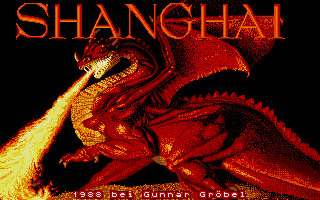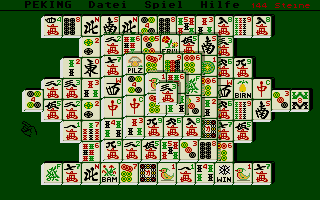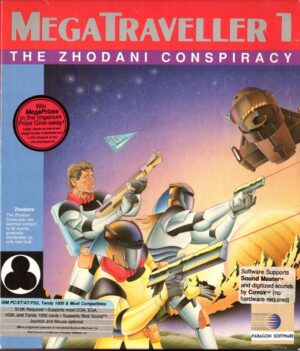Retro Replay Review
Gameplay
Peking 2.0 takes the classic tile-matching puzzle formula and refines it with thoughtful features that cater both to newcomers and seasoned veterans. At its core, you’re presented with a pyramid of patterned tiles viewed from above, and your goal is to remove matching pairs that aren’t covered by any other tiles. This simple rule set belies a deep strategic layer: every move shifts the remaining configuration, and one false pair removal can strand key tiles and force a restart.
The 2.0 edition bolsters this foundation with a robust suite of quality-of-life additions. You can save and load your game at any point, ensuring that even marathon sessions don’t have to be lost to an untimely power flicker. A built-in undo lets you backtrack a misstep, while a hint function highlights available matches when you hit a mental block. More adventurous players can even remove tiles at will, essentially letting them bypass tough spots in exchange for a slightly deflated sense of accomplishment.
For those who thrive on competition, Peking 2.0 offers a two-player mode where each participant has a fixed number of seconds to find a match before the mouse cursor switches hands. This head-to-head dynamic brings a fresh layer of tension to what is typically a solitary pastime: watching your rival scramble for a pair or risk forfeiting precious time creates adrenaline-fueled moments and a lively party-game atmosphere.
Finally, the variety of tile sets ensures that repetition never becomes dull. Beyond the traditional mahjong tiles, you’ll unlock sets featuring national flags, international traffic signs, and whimsical pictograms. Each new aesthetic not only refreshes the visual appeal but also subtly changes how you recognize and pair tiles, adding an unexpected twist to a familiar mechanic.
Graphics
As an Atari ST release, Peking 2.0’s graphics remain charmingly retro without ever feeling cramped or cluttered. Tiles are rendered with crisp edges and clear icons, whether you’re in high-resolution color mode or black-and-white low resolution. The overhead perspective is intuitive, giving you a full view of the pyramid structure and making spatial relationships between tiles easy to gauge.
The inclusion of multiple tile themes is a standout graphical feature. The mahjong set captures traditional East-Asian iconography with stylized bamboo, circles, and characters, while the flag set offers bright, instantly recognizable national emblems. The traffic signs feel playfully modern, and the pictograms are delightfully abstract—each set feels distinct and well-designed, breathing fresh life into repeated play sessions.
Screen management tools, such as the screenshot function, let you capture memorable moments—perhaps the instant you clear that impossible layout or beat a rival in two-player mode. Though the Atari ST’s palette is limited by today’s standards, the thoughtful use of color contrasts ensures that matching pairs stand out clearly, minimizing eye strain during marathon puzzles.
Story
Peking 2.0 isn’t a story-driven adventure, and it doesn’t pretend to be. There’s no grand narrative, no characters to befriend or worlds to explore—just the timeless satisfaction of clearing tiles. If you’re seeking a plot-rich experience, this isn’t the title for you. Instead, consider the “story” here to be the unfolding puzzle itself: the ebb and flow of available matches, the rising tension as the pyramid shrinks, and the ultimate triumph of a perfectly executed clearance.
That said, the game’s gentle East-Asian motif provides a subtle thematic framework. The tile designs evoke traditional Mahjong without directly borrowing any of its cultural trappings beyond the visuals. This sparse thematic layer keeps the focus squarely on gameplay, while still granting the puzzle a distinctive identity that differentiates it from generic matching games.
In the absence of character arcs or dialogue, Peking 2.0’s narrative emerges organically from the challenge it presents. Each session tells a mini-story of progress, miscalculation, and (hopefully) ultimate success. For players who find meaning in mastering mechanics rather than following plot threads, that intangible arc can be just as compelling as the best scripted tale.
Overall Experience
Peking 2.0 delivers a polished, feature-rich take on a beloved puzzle genre. Its blend of classic tile-matching mechanics with modern conveniences—save/load, undo, hints, and cheat options—strikes a careful balance between pure challenge and player accessibility. Whether you’re tackling the game in short bursts or settling in for hours, the array of options ensures you can tailor the experience to your mood.
Two-player mode is a particularly welcome addition, transforming what is typically a solitary exercise into an energetic shared experience. The timed-turn mechanic keeps both players engaged and introduces a strategic tug-of-war: do you rush for quick matches or wait for an optimal play that may cost you precious seconds?
The graphical variety, spanning multiple tilesets and resolution modes, ensures that Peking 2.0 feels fresh across repeated sessions. Even without a narrative or campaign structure, the game maintains a compelling loop of puzzle solving, aesthetic appreciation, and personal progression—especially for those keen on topping their own best times or outwitting a friend.
In sum, Peking 2.0 stands out as an exemplary Atari ST puzzle title. It doesn’t revolutionize the genre, but it refines and enhances it in ways that remain engaging decades later. If you appreciate focused, mentally stimulating gameplay and enjoy the occasional competitive head-to-head challenge, this is a title well worth your time and attention.
 Retro Replay Retro Replay gaming reviews, news, emulation, geek stuff and more!
Retro Replay Retro Replay gaming reviews, news, emulation, geek stuff and more!









Reviews
There are no reviews yet.